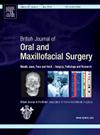Efficacy of the Hegab temporomandibular joint splint in treating patients diagnosed with dystonia with or without systemic involvement: A report of 14 cases
IF 1.7
4区 医学
Q3 DENTISTRY, ORAL SURGERY & MEDICINE
British Journal of Oral & Maxillofacial Surgery
Pub Date : 2024-12-01
DOI:10.1016/j.bjoms.2024.09.002
引用次数: 0
Abstract
Dystonia is a neurological motor disorder characterised by involuntary and uncontrollable muscle contractions, tension, twisting, and tremors. The aim of the present study was to analyse the improvement in dystonic contractions in patients with dystonia following the use of a Hegab temporomandibular joint splint (HTS). The Fahn-Marsden Dystonia Movement Scale (DMS) and Disability Scale were used in the current study to evaluate dystonia. An HTS with a thickness ranging from 4 to 6 mm was used to treat the patients enrolled in the study. The final sample comprised 14 patients (10 female and four male) with mean (range) ages of 35.64 (18 to 55) years. Pre-treatment DMS ranged from 6.5 to 57 mean (SD) 18.21 (13.38). At the end of the study, DMS ranged from 0 to 15 mean (SD) 3.14 (3.86). Statistical analysis of the differences between pre-treatment and post-treatment DMS showed a significant decrease in DMS at the end of the treatment period (p = 0.0001). Regarding the disability scale, pre-treatment disability scale ranged from 7 to 18 mean (SD) 9.46 (3.02). At the end of the study, DMS ranged from 0 to 3 mean (SD) 1.46 (1.13). There was a statistically highly significant decrease in the Disability Scale at the end of the treatment period (p value ≤ 0.0001). This study suggests that the HTS can be considered an effective treatment modality for dystonia, as it significantly decreases both the DMS and the Disability scale.
Hegab 颞下颌关节夹板治疗伴有或不伴有全身性肌张力障碍患者的疗效:14 个病例的报告。
肌张力障碍是一种神经性运动障碍,主要表现为肌肉不自主的、无法控制的收缩、紧张、扭曲和震颤。本研究旨在分析使用 Hegab 颞下颌关节夹板(HTS)后肌张力障碍患者肌张力收缩的改善情况。本研究使用法恩-马斯登肌张力障碍运动量表(DMS)和残疾量表来评估肌张力障碍。研究中使用了厚度为 4 至 6 毫米的 HTS 来治疗患者。最终样本包括 14 名患者(10 名女性和 4 名男性),平均年龄为 35.64(18 至 55)岁。治疗前的 DMS 为 6.5 至 57,平均(标清)为 18.21(13.38)。研究结束时,DMS 在 0 至 15 之间,平均(标清)为 3.14 (3.86)。对治疗前和治疗后 DMS 差异的统计分析显示,治疗结束时 DMS 显著下降(p = 0.0001)。在残疾量表方面,治疗前的残疾量表介于 7 至 18 之间,平均(标清)为 9.46(3.02)。研究结束时,残疾量表介于 0 至 3 之间,平均(标清)为 1.46 (1.13)。在治疗期结束时,残疾量表的下降具有高度统计学意义(P 值≤ 0.0001)。这项研究表明,HTS 可显著降低肌张力障碍量表和残疾量表,因此可被视为治疗肌张力障碍的有效方法。
本文章由计算机程序翻译,如有差异,请以英文原文为准。
求助全文
约1分钟内获得全文
求助全文
来源期刊
CiteScore
3.60
自引率
16.70%
发文量
256
审稿时长
6 months
期刊介绍:
Journal of the British Association of Oral and Maxillofacial Surgeons:
• Leading articles on all aspects of surgery in the oro-facial and head and neck region
• One of the largest circulations of any international journal in this field
• Dedicated to enhancing surgical expertise.

 求助内容:
求助内容: 应助结果提醒方式:
应助结果提醒方式:


